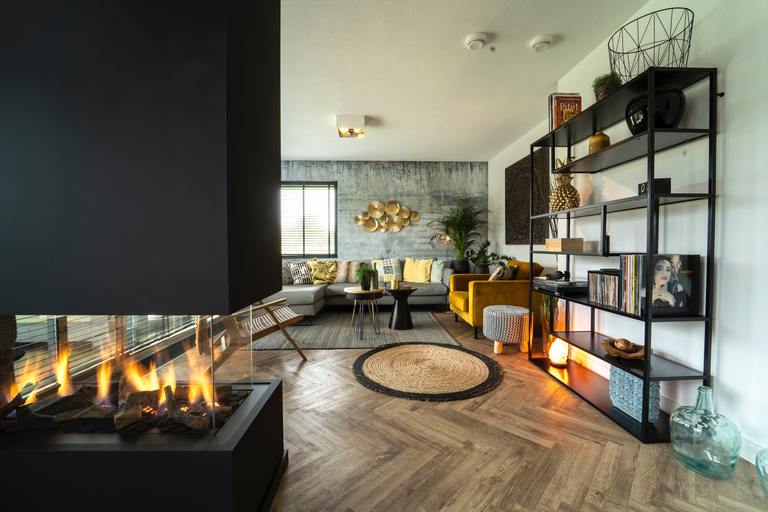How to Make a Blue Flame in Photoshop
How to Make Flames in Photoshop
As an Amazon Associate we earn from qualifying purchases. Perhaps you've seen tutorials virtually putting flames on text, yet yous're still having problem making a fireplace expect convincing. This is why we're giving you several editing options to notice the all-time mode on how to make flames or burn down in Photoshop and attain more realistic real estate photos. Quick Navigation The first way to edit flames in Adobe Photoshop is to employ flame brushes and patterns. Another option is to optimize the Render Flames tool or the Flame Generator filter and then that you can adjust the flame manner, shape, and other parameters. Whether you want to heighten the existing fire or create a flame from scratch on an paradigm, the software has diverse tools and techniques to better your real estate photos. Follow this stride-by-step process to put authentic-looking flames in your existent estate images. Quicker than using the brushes is optimizing the new Return Flames tool. Information technology'southward a very powerful and dynamic tool that lets y'all add flame in but a few steps where there otherwise wasn't one in your photograph. In this video, I demonstrate step by footstep how y'all tin accept the software render a flame into a fireplace. The aforementioned process can besides be used to artificially light candles or put flame to an outdoor firepit in your twilight epitome if information technology wasn't possible to do and then while shooting. As with just well-nigh everything in the plan, there are a few options to reach these effects. Get-go, create your path using the pen tool or any of the shape tools. Afterward that, select Filter > Render > Flames. Ensure that you have a targeted pixel layer in the Layers panel as a landing place for your flame. The filter enables aligning to the type of flame y'all tin make. The software provides 3 different flame styles. The starting time one is Normal, which is like a basic flame. Using the Violent way produces harsher flames with brighter furnishings, while Flat lacks dimension or depth. Later on setting the flame style, you tin can as well modify the flame shape to Parallel to keep the flames in an upwards position or employ Spread to make the flames spread outward from the center. Another option is To The Middle, which points the flames toward the center. On the other paw, Oval directs the flames to go out from the bottom and come back in, whereas Pointing makes the flames converge at ane point. The nearly basic parameters are Length, Width, Bending, and Interval, which y'all can all adjust in pixels. For a more avant-garde setting, you tin check the Adjust Interval For Loops to adjust and fifty-fifty out the gaps between the flames on a certain path. Another option is to alter the Flame Lines setting to decrease or increase each flame's number of lines. You lot can also set the roughness and calmness of the flames by clicking on the Turbulent setting. Yes, in that location is more to skilful-looking fires than only the flame. You need logs on grates etc. My approach is using an actual flame with logs and all the support from a existent flame. The way to practice this is as follows: It's possible that you're working on a Type layer or a Smart Object. The Render Flames filter only works on pixel layers. Equally a full general rule, real estate photographers can edit images every bit long as they don't entirely modify the holding or misrepresent the perspective. However, this may depend on the requests of the clients, so settle this before editing. For Lightroom, you tin can adjust the exposure to even out the light, desaturate colors to play with the hue, use lens correction to straighten lines and exercise color correction. Every bit you tin can see, there are several ways for you to quickly create flames, as well every bit advanced methods for a more sophisticated flame effect. Whichever you cull, it's important that you understand the Photoshop tools and techniques properly for more than seamless editing. How do yous attain a similar issue in your photos? Is this something y'all regularly exercise in your workflow? Practise y'all offer this equally an improver service?
How to Make Flames in Photoshop
Using Flame Brushes and Patterns

Render Flames Tool and Layers Panel
Form a Path for the Flames
Choose the Flame Type

Change the Flame Style and Shape
Adjust Parameters
Enhancing the Existing Flames
Frequently Asked Questions
Why Tin can't I Run across the Render Flames Filter?
Tin I Manipulate Real Estate Images?
How Can I Edit Real Manor Photos in Lightroom?
Decision
Source: https://photographyforrealestate.net/how-to-quickly-add-fire-to-a-fireplace-in-photoshop/